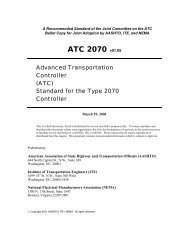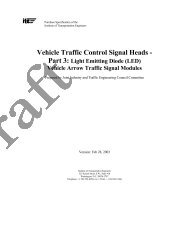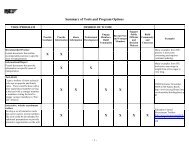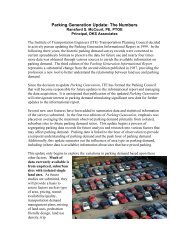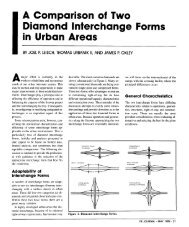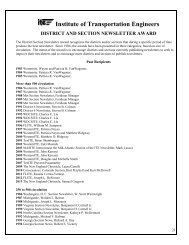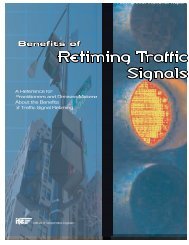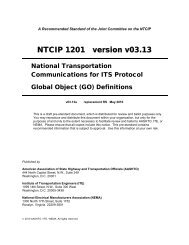Vehicle Traffic Control Signal Heads: - Institute of Transportation ...
Vehicle Traffic Control Signal Heads: - Institute of Transportation ...
Vehicle Traffic Control Signal Heads: - Institute of Transportation ...
You also want an ePaper? Increase the reach of your titles
YUMPU automatically turns print PDFs into web optimized ePapers that Google loves.
terminal voltage shall decay to a value less than<br />
10 VAC RMS in less than 100 milliseconds when<br />
driven by a maximum allowed load switch<br />
leakage current <strong>of</strong> 10 milliamps peak (7.1<br />
milliamps AC).<br />
5.7 Failed State Impedance<br />
The module shall be designed to detect<br />
catastrophic loss <strong>of</strong> the LED load. Upon sensing<br />
the loss <strong>of</strong> the LED load, the module shall present<br />
a resistance <strong>of</strong> at least 250 kΩ across the input<br />
power leads within 300 msec. The LED light<br />
source will be said to have failed catastrophically<br />
if it fails to show any visible illumination when<br />
energized according to Section 5.2.1 after 75<br />
msec.<br />
5.8 Nighttime Dimming (Optional)<br />
5.8.1 When requested, the module circuitry shall<br />
allow a reduction <strong>of</strong> the intensity <strong>of</strong> the light<br />
output in response to an input from the traffic<br />
signal controller.<br />
5.8.2 Dimming, if provided, shall reduce light<br />
output to levels established to match ambient<br />
lighting conditions. Dimming may be in stepped<br />
increments or may be continuously variable. The<br />
minimum light output, when dimmed, shall not be<br />
less than 30 percent <strong>of</strong> the minimum maintained<br />
luminous intensity, as defined in Section 4.1.1.<br />
6. Quality Assurance<br />
6.1 General<br />
6.1.1 Quality Assurance Program: Modules shall<br />
be manufactured in accordance with a vendor<br />
quality assurance (QA) program. The QA<br />
program shall include two types <strong>of</strong> quality<br />
assurance: (1) design quality assurance and (2)<br />
production quality assurance. The production<br />
quality assurance shall include statistically<br />
controlled routine tests to ensure minimum<br />
performance levels <strong>of</strong> modules built to meet this<br />
specification.<br />
6.1.2 Record Keeping: QA process and test results<br />
documentation shall be kept on file for a<br />
minimum period <strong>of</strong> 7 years.<br />
6.1.3 Conformance: Module designs not<br />
satisfying design qualification testing and the<br />
production quality assurance testing performance<br />
requirements in Sections 6.3 and 6.4 shall not be<br />
labeled, advertised, or sold as conforming to this<br />
specification.<br />
6.2 Manufacturers’ Serial Numbers<br />
Each module shall be identified with the<br />
information specified in paragraph 3.6.1.<br />
6.3 Production Tests and Inspections<br />
6.3.1 Production Test Requirements: All modules<br />
tendered for sale shall undergo the following<br />
Production Testing and Inspection prior to<br />
shipment. Failure <strong>of</strong> a module to meet the<br />
requirements <strong>of</strong> Production Testing and<br />
Inspection shall be cause for rejection. Test results<br />
shall be maintained per the requirement <strong>of</strong> Section<br />
6.1.2.<br />
6.3.1.1 All Production Tests shall be performed at<br />
an ambient temperature <strong>of</strong> 25ºC (77ºF) and at the<br />
nominal operating voltage <strong>of</strong> 120 VAC.<br />
6.3.2 Luminous Intensity: All modules shall be<br />
tested for luminous intensity. A single point<br />
measurement, with a correlation to the intensity<br />
requirements <strong>of</strong> Sections 4.1.1 and 4.1.2 may be<br />
used. The purchaser may specify additional<br />
measurements. Failure <strong>of</strong> a module to meet the<br />
requirements for minimum maintained luminous<br />
intensity (4.1.1) or maximum permissible<br />
luminous intensity (4.1.2) shall be cause for<br />
rejection <strong>of</strong> the module.<br />
6.3.3 Power Factor: All modules shall be tested<br />
for power factor per the requirements <strong>of</strong> Section<br />
5.5.1. A commercially available power factor<br />
meter may be used to perform this measurement.<br />
Failure <strong>of</strong> a module to meet the requirements for<br />
power factor (5.5.1) shall be cause for rejection<br />
<strong>of</strong> the module.<br />
6.3.4 Current Consumption Measurement: All<br />
modules shall be measured for current flow in<br />
amperes. The measured current values shall be<br />
compared against the design current values from<br />
design qualification measurements in Section<br />
6



